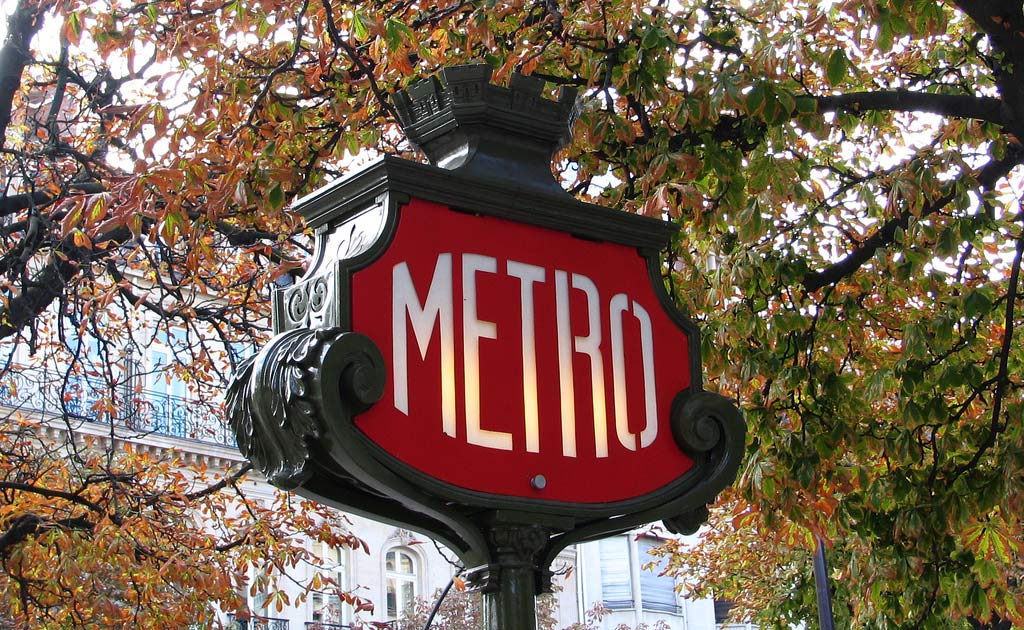The Paris Metro (ok, really it’s the Métro with an accent over the “e”) is one of the fastest and cheapest ways to get around the city–as long as you know how to navigate it properly. And that’s exactly what I’m going to tell you how to do, having done it myself with my husband and two daughters!

My family and I rode it a lot during our five-day stay and we found it challenging at first, even though we speak some French. We wasted money by accidentally using up tickets because we got lost, and spent quite a bit of time pondering the automatic ticket machines. The truth is we were “winging it.”
If you read the tips below and study the station maps before you head out the door of your hotel, chances are you’ll do fine. Plus, it’s definitely worth the effort when your feet are tired from walking and you don’t want to spend hefty sums on taxis!
Before you go:
- Check out my articles about the 25 Netflix movies set in Paris and the 7 prettiest streets in Paris.
- If you’re looking for a place to stay, you can check out and book Paris hotels on Hotels.com. I’ve used the website and it worked out great for me. You can also check out their Deals Hub for discounted rates. I also like using the Expedia website for booking things.
- Take a look at the Air France best offers and promotions, which also includes last-minute deals
>>Affiliate notice: I research every product I recommend, and I only give high marks to the very best. Some of the links here may be affiliate links, which means I may receive compensation from companies if you purchase from them. This is at no cost to you and it helps me keep this website running. So thanks for helping me! I independently own this site and the opinions expressed here are my own.<<
How to Get Around on the Paris Metro Lines
There are 16 Metro lines that you can identify by their number, color, or the last stop on them, which gives them their official name. Some lines split into two lines at certain points (e.g., Line 7 and Line 13), so check the destination on the train before you get on. When you get to a station, look for the Plan du Quartier, or neighborhood map, which can help orient you. You can also download the Metro map.
For an app map, check out the RATP app.
If you want a great view of the city, ride Lines 6 and 2, which run above ground. Line 6 has great views of the Eiffel Tower.
Here are some of the most popular stops for tourists:
- Line 1 (La Défense/Château de Vincennes): These stops include the Louvre, Champs-Elysées, Chatelet, and Bastille.
- Line 2 (Porte Dauphine/Nation): These stops include Anvers (Sacre Coeur), Gare du Nord, Champs-Elysées, and Père-Lachaise.
- Line 3 (Pont de Levallois – Bécon/Gallieni): These stops include St. Lazare, République, and Père-Lachaise.
- Line 4 (Porte de Clignancourt/Mairie de Montrouge): These stops include Chatelet, St. Michel, and Montparnasse.
- Line 5 (Bobigny – Pablo Picasso/Place d’Italie): These stops include Gare d’Austerlitz, Bastille, and Place d’Italie.
- Line 6 (Charles de Gaulle-Etoile/Nation): These stops include the Eiffel Tower, Montparnasse, and Champs-Elysees.
- Line 7 (La Courneuve – 8 Mai 1945/Mairie d’Ivry and Villejuif – Louis Aragon): These stops include Place d’Italie, Louvre, and Opera. Be careful to check that the train you get on is heading to your destination; this line splits into two.
- Line 8 (Balard/Creteil): These stops include Invalides, Opéra, and Bastille.
- Line 9 (Pont de Sèvres/Mairie de Montreuil): These stops include Republique and Grands Magasins.
- Line 10 (Gare d’Austerlitz/Boulogne–Pont de Saint-Cloud): These stops include the Sorbonne and the Gare d’Austerlitz train station.
- Line 11 (Châtelet/Mairie des Lilas): These stops include Chatelet and Republique.
- Line 12 (Aubervillers-Front Populaire/Mairie d’Issy): These stops include Abbesses (Montmartre), Grands Magasins, and Montparnasse.
- Line 13 (Saint-Denis – Université/ Asnières–Gennevilliers-Les Courtilles/Châtillon–Montrouge:) These stops include Invalides and St. Lazare. Be careful to check that the train you get on is heading to your destination; this line splits into two.
- Line 14 (Saint-Lazare/Olympiades): These stops include Chatelet, Gare de Lyon, Bibliothèque Nationale, and the Saint-Lazare train station.
The Paris Metro Hours
The Metro runs from 5:30 a.m. to 1:15 a.m. Monday through Thursday. It runs until 2:15 a.m. on Friday and Saturday. Rush hour is from 8 to 10 a.m. and 5 to 8 p.m. during weekdays. Avoid it during these hours if you don’t want to get caught up in huge crowds.
Buying and Using Metro Tickets
The Paris Metro works with the same tickets as the RER (high-speedcommuter trains) and buses. However, if you decide to ride the Metro and the RER or a bus, you will need to purchase two tickets. The RER is what you’ll take to Versailles, the airport, and Disneyland Paris.
One ticket costs €1.80 (i.e., 1.8 Euros). You can buy a carnet (pronounced “kar-nay”) of tickets, which will save you money per ticket; kids’ tickets are even cheaper. There is also a chip card called the Passe Navigo, as well as a Paris Visite pass, but according to Rick Steves the carnet tickets are a better deal for tourists.
You can buy Metro tickets in the stations, or at Paris tourist information offices. In the stations, you can buy them from machines, but be prepared that some stations only accept coins and debit cards. You can also purchase tickets from the Vente (sales counter). If the counter is labeled “Information,” it means they do not sell tickets there; you will have to buy them from the machine.
Note that you can choose English for the machine, which helps.
The T+ ticket is good for one ride in zones 1 and 2 only, but can be used on the metro, RER, bus, or tramway.
BEWARE: If you go in the wrong direction and need to go back, you will have to exit the turnstile and pay again!!
If You Have Trouble Walking or Standing
Seats are hard to come by in the trains. Also, expect to walk a lot in the tunnels, which are often labyrinthine.
Do you have more advice for getting around on the Paris Metro? Please let me know by leaving a comment below.


















